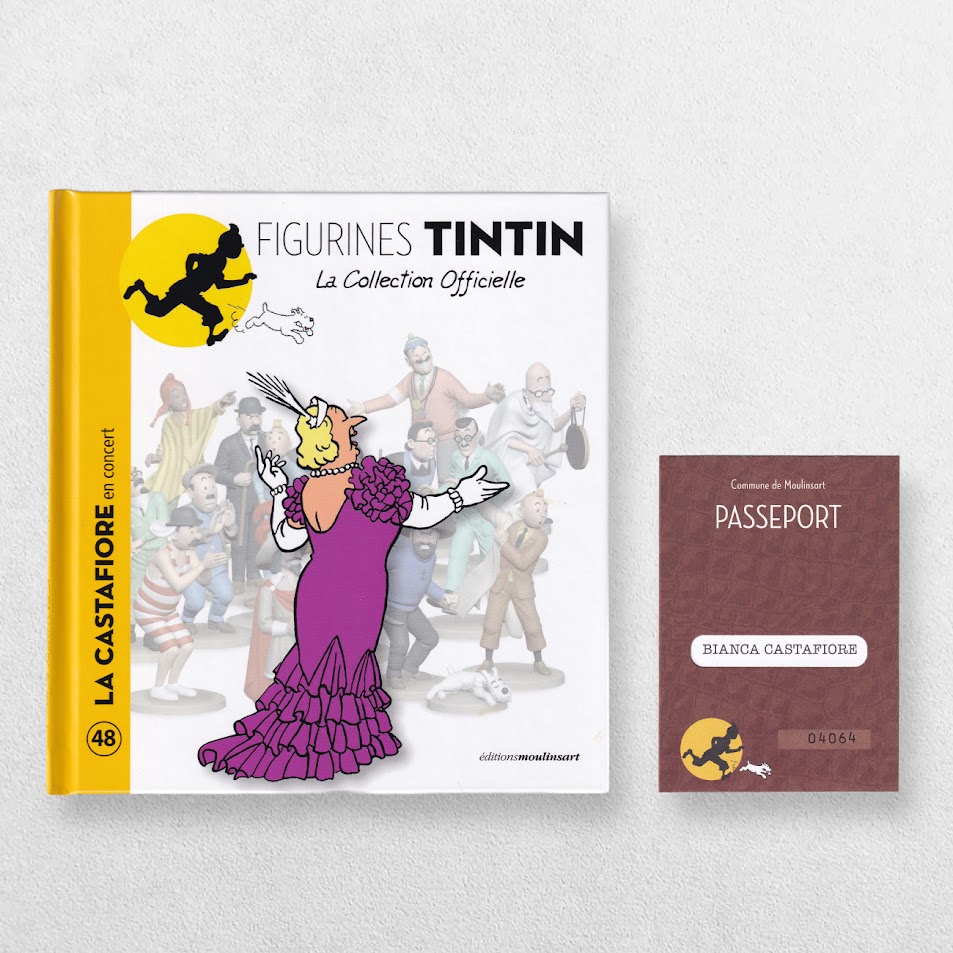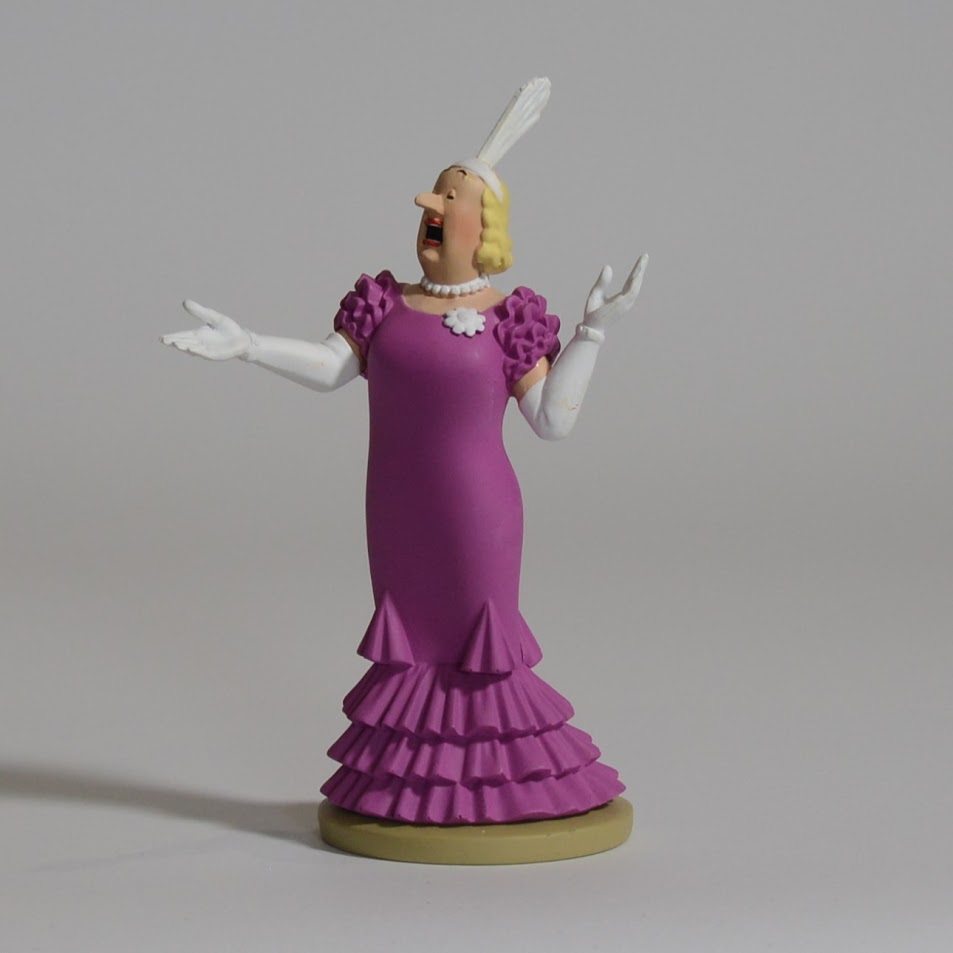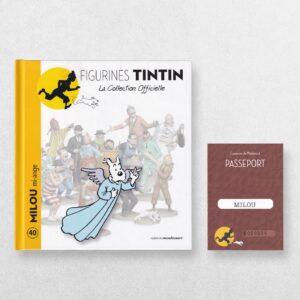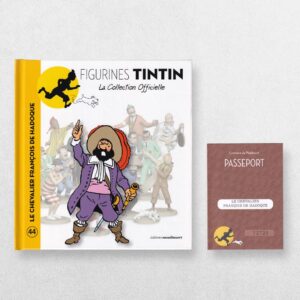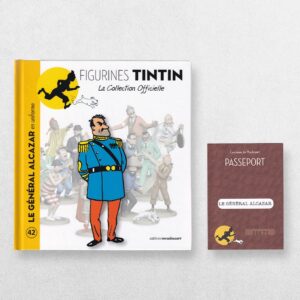Castafiore In Concert – Figurines Tintin La Collection Officielle – 48 – La Castafiore En Concert
Hergé & Editions Moulinsart
£45.00
Availability: In stock
Product Description
Castafiore In Concert – Figurines Tintin La Collection Officielle – 48 – La Castafiore En Concert
Author: Hergé & Editions Moulinsart
Price: £45.00
Publisher: Editions Moulinsart
Publication date: 2013
Format: Original pictorial boards with passport and figurine
Condition: In very good condition
Illustrations: Illustrated throughout
Description:
Original pictorial boards. Includes passport loosely inserted. Text in French. Includes the accompanying figurine. One from the collection of 111 books and figurines. Very slight wear. Headpiece has been cracked and re-attached. In very good, clean condition overall.
Bianca Castafiore: A Short Biography
Bianca Castafiore, famously known as The Milanese Nightingale, is one of Hergé’s most iconic creations — a world-renowned opera singer whose larger-than-life personality brings comedy, warmth, and unexpected depth to The Adventures of Tintin.
Her appearances across multiple albums — from King Ottokar’s Sceptre (1939) to Tintin and the Picaros (1976) — reveal her as more than mere comic relief. She represents fame, vanity, and resilience, but also independence and integrity.
Character Overview
Bianca Castafiore is an Italian soprano of international acclaim. Her flamboyant manner, passion for music, and complete obliviousness to chaos around her make her one of the most humorous and memorable characters in Hergé’s universe.
She is usually seen wearing elegant gowns, adorned with jewels — especially her cherished emerald — and accompanied by her devoted maid, Irma, and pianist, Igor Wagner. Her voice, while celebrated within the Tintin world, is notoriously intolerable to those around her, especially Captain Haddock.
Her signature aria, “Ah! je ris de me voir si belle en ce miroir” (“Ah, I laugh to see myself so fair in this mirror”) from Charles Gounod’s Faust, recurs throughout the series, signalling her entrances and often heralding comic disaster.
First Appearance: King Ottokar’s Sceptre (1939)
Castafiore makes her debut in King Ottokar’s Sceptre, performing at the court of Syldavia. Already at this early stage, Hergé presents her as exuberant, charming, and somewhat self-absorbed — her singing interrupts political intrigue, her laughter fills the room, and her presence lightens Tintin’s otherwise serious adventure.
Role in Later Adventures
The Calculus Affair (1956)
Castafiore reappears in The Calculus Affair, visiting Marlinspike Hall while the heroes are caught in a dangerous espionage plot. Her lack of awareness of the tension around her provides both humour and relief. She treats the whole affair as an operatic melodrama, oblivious to danger. Her good nature and unflappable confidence make her a counterpoint to Captain Haddock’s exasperation.
The Castafiore Emerald (1963)
This is her defining story and one of Hergé’s most sophisticated works. The entire narrative unfolds at Marlinspike Hall, where Castafiore arrives for a stay. She is accompanied by her entourage and her prized emerald, which soon becomes the centre of a supposed mystery.
The story is remarkable in that there is no real crime, villain, or adventure — only misunderstandings, misplaced assumptions, and human foibles. Castafiore becomes the inadvertent cause of chaos: the press fabricates a romance between her and Captain Haddock; servants panic; journalists swarm; and the emerald goes missing (temporarily, due to a magpie).
Through it all, Castafiore remains calm, generous, and good-humoured — entirely unbothered by gossip or scandal. Hergé uses her to explore themes of perception, celebrity, and the unreliability of appearances.
Tintin and the Picaros (1976)
In her final appearance, Castafiore travels to San Theodoros to perform for General Tapioca’s regime, only to become embroiled — again unintentionally — in revolution. Despite imprisonment and political turmoil, she maintains her dignity and optimism. Her faith in art and beauty endures even amid absurdity.
Personality and Traits
Bianca Castafiore’s character is a study in contradictions:
- Vain yet kind-hearted: She loves her reflection and her fame, but she is generous and well-meaning.
- Oblivious yet perceptive: She often misses obvious danger but senses emotional undercurrents others ignore.
- Loud yet lovable: Her exuberance and laughter bring vitality to otherwise tense scenes.
- Independent: She travels the world, commands respect, and fears no authority — a rare trait for women in early 20th-century comics.
Her cheerfulness, confidence, and indifference to ridicule make her a quietly empowering presence. She is her own person — impervious to others’ judgement.
Relationship with Captain Haddock
The dynamic between Castafiore and Captain Haddock is one of Hergé’s comic masterstrokes. Haddock, gruff and easily flustered, finds her visits intolerable: her singing shatters windows, her compliments overwhelm him, and her mispronunciations of his name — “Captain Paddock,” “Hammock,” or “Padlock” — drive him to fury.
Yet beneath the humour lies mutual respect. Castafiore genuinely likes Haddock and treats him with affection; Haddock, though exasperated, never acts cruelly towards her. Their encounters reveal the humanity behind both characters — his awkwardness and her warmth.
In The Castafiore Emerald, their relationship becomes a subtle satire of media sensationalism, as the press fabricates a romance between them — an absurdity both handle in their own ways: Haddock with indignation, Castafiore with amused grace.
Symbolism
Castafiore represents art, vanity, and resilience in a world dominated by male adventure and rationality. She is the embodiment of emotion, colour, and the comic unpredictability of life.
Her voice — simultaneously admired and unbearable — symbolises both beauty and disruption. Through her, Hergé celebrates individuality while mocking pretension.
Moreover, Castafiore is one of Tintin’s few recurring female characters. Though exaggerated, she is far from a stereotype: she is successful, independent, and self-sufficient. Her “diva” traits are balanced by humour, warmth, and intelligence.
Artistic and Literary Role
Hergé designed Castafiore as a recurring motif — the human storm that sweeps through order and routine. Her operatic entrances, expressive gestures, and musical motifs lend a theatrical rhythm to the stories.
In The Castafiore Emerald, she becomes the centre of what Hergé called a “comedy of errors.” The story, devoid of adventure or crime, relies on misunderstanding and misdirection — all revolving around her magnetic personality. The result is one of Hergé’s most mature and subtle achievements, often considered a masterpiece of visual and narrative timing.
Legacy
Bianca Castafiore remains one of Hergé’s greatest comic inventions: a figure of elegance, absurdity, and charm who transcends caricature. Readers may laugh at her vanity, but her strength and good humour make her indelibly sympathetic.
She is the embodiment of the phrase “the show must go on” — undeterred by scandal, imprisonment, or shattered glass. In the male-dominated world of Tintin, Castafiore’s presence asserts that beauty, emotion, and art have their own form of heroism.
Summary
- Full name: Bianca Castafiore
- Nationality: Italian
- Occupation: Opera singer (“The Milanese Nightingale”)
- First appearance: King Ottokar’s Sceptre (1939)
- Notable works: The Calculus Affair (1956), The Castafiore Emerald (1963), Tintin and the Picaros (1976)
- Traits: Glamorous, kind, dramatic, self-assured, vain but generous
- Symbolism: Represents art, emotion, and individuality; a comic yet dignified counterpoint to Tintin’s rational world
- Signature aria: “Ah! je ris de me voir si belle en ce miroir” from Faust by Gounod
Conclusion
Bianca Castafiore is both comic relief and cultural commentary — a diva whose song reverberates through the quiet discipline of Tintin’s world. She embodies confidence without cruelty, glamour without deceit, and joy without apology.
In her laughter and her music, Hergé captured something rare in adventure fiction: the exuberance of life itself, imperfect, dazzling, and entirely unashamed.
Why Buy from Us?
At Hornseys, we are committed to offering items that meet the highest standards of quality and authenticity. Our collection of objects and rare books are carefully curated to ensure each edition is a valuable piece of bibliographical history. Here’s what sets us apart:
- Authenticity and Provenance: Each item is meticulously researched and verified for authenticity and collation.
- Expert Curation: Our selection process focuses on significance, condition, and rarity, resulting in a collection that is both diverse and distinguished.
- Customer Satisfaction: We aim to provide an exceptional customer experience, from detailed descriptions to secure and prompt delivery of your purchase.
- Returns Policy: We offer an unconditional guarantee on every item. If you wish to return an item, it may be sent back to us within fourteen days of receipt. Please notify us in advance if you wish to do so. The item must be returned in the same condition as it was sent for a full refund.
Cataloguer: Daniel Hornsey
Daniel Hornsey has specialised in fine and rare books, ephemera, and collectors’ editions for over thirty years. As a long-standing member of the antiquarian book trade, he has advised private collectors, curated catalogues, and sourced works for leading dealers, libraries and institutions across the world.
Hornseys’ exhibit regularly at book and map fairs in London and throughout the UK and are members of the Provincial Booksellers Fairs Association, the PBFA.
His fascination with Hergé’s work — especially ‘The Adventures of Tintin’ — began in childhood. Daniel recalls reading Tintin in original European editions and quickly recognising that these were not merely children’s books, but finely illustrated narratives crafted with artistic depth and wit.
As noted by the Musée Hergé in Louvain-la-Neuve, Hergé’s ‘ligne claire’ style has influenced generations of European comic artists and his original drawings and paintings command very high prices with his painting of ‘The Blue Lotus’ jar fetching £2.8m at auction in 2021.
By presenting these works through Hornseys’, he hopes to contribute to the continued appreciation of one of the 20th century’s most influential illustrators, helping new generations discover the artistry and legacy of Hergé.
Related products
The Fairies Or The Tales Of Mother Goose Corrected Typescript: Presentation Copy To John Arlott
£275.00Disher, M Willson
Snowy The Half-Angel – Figurines Tintin La Collection Officielle – 40 – Milou Mi-Ange
£65.00Hergé & Editions Moulinsart
The Crayon Box: The Day The Crayons Quit & The Day The Crayons Came Home: Includes Original Oliver Jeffers Art Print
£28.00Jeffers, Oliver & Daywalt, Drew
You may also like…
Bobby Smiles Menacing – Figurines Tintin La Collection Officielle – 47 – Bobby Smiles Menaçant
£75.00Hergé & Editions Moulinsart
Sir Francis Haddock – Figurines Tintin La Collection Officielle – 44 – Le Chevalier François De Hadoque
£95.00Hergé & Editions Moulinsart
General Alcazar In Uniform – Figurines Tintin La Collection Officielle – 42 – Le Général Alcazar En Uniforme
£45.00Hergé & Editions Moulinsart
Colonel Sponsz Upset – Figurines Tintin La Collection Officielle – 37 – Le Colonel Sponsz Contrarié
£55.00Hergé & Editions Moulinsart
Monsieur Boullu The Stonemason – Figurines Tintin La Collection Officielle – 35 – Monsieur Boullu Le Marbrier
£40.00Hergé & Editions Moulinsart
Haddock Alpinist – Figurines Tintin La Collection Officielle – 34 – Haddock En Alpiniste
£45.00Hergé & Editions Moulinsart
Calculus The Gardener – Figurines Tintin La Collection Officielle – 28 – Tournesol En Jardinier
£35.00Hergé & Editions Moulinsart
Haddock As Hadoque – Figurines Tintin La Collection Officielle – 24 – Haddock En Hadoque
£45.00Hergé & Editions Moulinsart
Ridgewell The Explorer – Figurines Tintin La Collection Officielle – 23 – Ridgewell L’Explorateur
£45.00Hergé & Editions Moulinsart
Tintin In Kilt – Figurines Tintin La Collection Officielle – 22 – Tintin En Kilt
£65.00Hergé & Editions Moulinsart
King Muskar Puts On His Gloves – Figurines Tintin La Collection Officielle – 20 – Le Roi Muskar Enfile Ses Gants
£45.00Hergé & Editions Moulinsart
Snowy Stuck In The Crab Tin – Figurines Tintin La Collection Officielle – 19 – Milou Coincé Dans La Boîte De Crabe
£45.00Hergé & Editions Moulinsart
Nestor With The Tray – Figurines Tintin La Collection Officielle – 18 – Nestor Au Plateau
£45.00Hergé & Editions Moulinsart
Chang Points Out Hou Kou – Figurines Tintin La Collection Officielle – 8 – Tchang Indique Hou Kou
£35.00Hergé & Editions Moulinsart
Tintin In A Lunar Spacesuit – Figurines Tintin La Collection Officielle – 7 – Tintin En Scaphandre Lunaire
£55.00Hergé & Editions Moulinsart
Snowy Carries His Bone – Figurines Tintin La Collection Officielle – 6 – Milou Promène Son Os
£40.00Hergé & Editions Moulinsart
Castafiore With The Parrot – Figurines Tintin La Collection Officielle – 5 – La Castafiore Au Perroquet
£75.00Hergé & Editions Moulinsart
Thomson Looking Awkward – Figurines Tintin La Collection Officielle – 4 – Dupond Engoncé
£40.00Hergé & Editions Moulinsart
Professor Calculus With A Spade – Figurines Tintin La Collection Officielle – 3 – Tournesol A La Bêche
£40.00Hergé & Editions Moulinsart
Haddock Doubtful – Figurines Tintin La Collection Officielle – 2 – Haddock Dubitatif
£40.00Hergé & Editions Moulinsart
Tintin In Trenchcoat – Figurines Tintin La Collection Officielle – 1 – Tintin En Trench-Coat
£75.00Hergé & Editions Moulinsart

